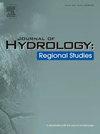基于多源数据融合的呼伦湖流域陆地蓄水重建及气候-土地覆被相互作用评估
IF 5
2区 地球科学
Q1 WATER RESOURCES
引用次数: 0
摘要
研究区域呼伦湖流域(HLB)是中国北部和蒙古的一个跨越218,000 平方公里的大型跨境流域研究重点了解数据稀缺、气候敏感地区的长期陆地储水(TWS)动态对可持续流域管理至关重要。利用随机森林和卡尔曼滤波的融合模型重构了1960 - 2023年的连续TWS和地下水储水量(GWS)时间序列。利用多源数据,分析干旱半干旱高原对气候变化和土地覆盖变化的非线性水文响应。重建的TWS揭示了气候变化驱动的四个不同的水文阶段:冷干(1972-1981)、冷湿(1981-1990)、暖干(1990-2007)和暖湿(2007-2021)。由于降水持续低于蒸散量,观测到净水分亏缺,并伴有0.04°C/年的变暖趋势,超过全球平均值。地下水是TWS变化的主要驱动因素,降水表现出最高的气候弹性。1990年至2005年期间,尽管土地覆盖稳定,但TWS急剧下降(降水下降~ 36% %)。2005-2020年,显著的TWS增长集中在Ulson河流域的贫瘠土地上,而Kherlen河流域恢复有限,反映了土地覆盖影响的空间异质性。这些发现突出了不同子流域的不对称水文响应,并为未来气候变化条件下的水资源规划提供了有价值的数据集。本文章由计算机程序翻译,如有差异,请以英文原文为准。
Reconstructing terrestrial water storage and assessing climate–land cover interactions in the Hulun Lake Basin using multi-source data fusion
Study Region
Hulun Lake Basin (HLB), a large transboundary watershed spanning 218,000 km² in northern China and Mongolia
Study Focus
Understanding long-term terrestrial water storage (TWS) dynamics in data-scarce, climate-sensitive regions is critical for sustainable watershed management. This study reconstructs a continuous TWS and groundwater storage (GWS) time series from 1960 to 2023 using a fusion model integrating Random Forest and Kalman Filter algorithms. By leveraging multi-source datasets, the study aims to analyse the nonlinear hydrological response to climate change and land cover shifts in the arid and semi-arid HLB.
New hydrological insights for the region
The reconstructed TWS revealed four distinct hydrological phases driven by climate variability: cold-dry (1972–1981), cold-wet (1981–1990), warm-dry (1990–2007), and warm-wet (2007–2021). A net water deficit was observed due to precipitation consistently falling below evapotranspiration, accompanied by a warming trend of 0.04 °C/year—exceeding the global mean. Groundwater was identified as the dominant driver of TWS changes, with precipitation showing the highest climatic elasticity. Between 1990 and 2005, TWS sharply declined (∼36 % drop in precipitation) despite stable land cover. From 2005–2020, notable TWS gains were concentrated in barren lands within the Ulson River Basin, while limited recovery in the Kherlen River Basin reflected spatial heterogeneity in land cover influence. These findings highlight the asymmetric hydrological responses across sub-basins and offer a valuable dataset for future water resource planning under changing climate conditions.
求助全文
通过发布文献求助,成功后即可免费获取论文全文。
去求助
来源期刊

Journal of Hydrology-Regional Studies
Earth and Planetary Sciences-Earth and Planetary Sciences (miscellaneous)
CiteScore
6.70
自引率
8.50%
发文量
284
审稿时长
60 days
期刊介绍:
Journal of Hydrology: Regional Studies publishes original research papers enhancing the science of hydrology and aiming at region-specific problems, past and future conditions, analysis, review and solutions. The journal particularly welcomes research papers that deliver new insights into region-specific hydrological processes and responses to changing conditions, as well as contributions that incorporate interdisciplinarity and translational science.
 求助内容:
求助内容: 应助结果提醒方式:
应助结果提醒方式:


